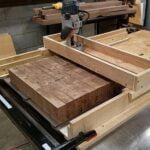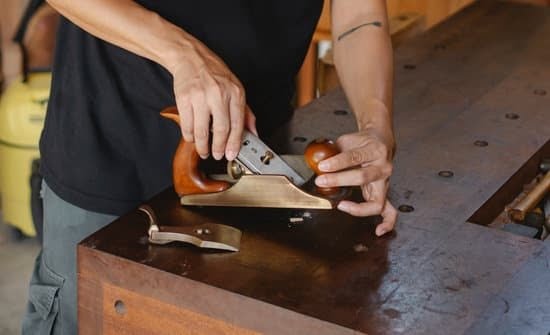What are biscuits in woodworking? Biscuits in woodworking are small, thin ovals of wood that are used to join two pieces of wood together. They are essential in creating strong and durable connections, commonly used in cabinet making, furniture construction, and other woodworking projects.
Biscuit joinery has a rich history that dates back to the 1950s when it was first patented and introduced as a method of joining wood. Over the years, biscuits have become an integral part of woodworking, offering a simple and effective way to create seamless joints.
In this article, we will delve into the concept of biscuits in woodworking, their historical significance, the different types of biscuits available, the benefits of using them, and how to effectively incorporate them into your woodworking projects. We will also discuss the tools and equipment needed for biscuit joinery, common mistakes to avoid, and showcase inspiring examples of biscuit joinery projects.
Whether you’re a beginner or an experienced woodworker, understanding the role of biscuits in woodworking is crucial for achieving high-quality results.
History of Biscuit Joinery
Biscuit joinery, also known as plate joinery, is a woodworking technique that involves joining two pieces of wood together using small oval-shaped wooden biscuits. These biscuits are made from compressed beech wood and are often used in conjunction with glue to create strong and seamless joints in woodworking projects. But where did this technique come from, and how has it evolved over time?
Origins of Biscuit Joinery
The concept of biscuit joinery can be traced back to the 1950s when Swiss carpenter Hermann Steiner developed the first biscuit joiner. This revolutionary tool allowed woodworkers to cut matching slots in two pieces of wood, into which the biscuits could be inserted for a secure joint. The simplicity and effectiveness of this method quickly gained popularity among woodworkers, leading to its widespread adoption in the industry.
Evolution of Biscuits in Woodworking
Over the years, biscuit joinery has seen advancements in both the tools used and the types of biscuits available. Modern biscuit joiners feature improved cutting mechanisms and adjustable fences, making them more versatile and user-friendly. Additionally, there are now different sizes and shapes of biscuits available, allowing for greater flexibility in woodworking projects. As technology continues to advance, we can expect further developments in biscuit joinery techniques and tools.
Understanding the history and evolution of biscuit joinery provides valuable insights into how this technique has become an integral part of woodworking today. By appreciating its origins, woodworkers can better utilize biscuits and continue to innovate new methods for joining wood effectively and efficiently.
Types of Biscuits
Biscuits in woodworking are small, thin, and oval-shaped wooden pieces used to join two pieces of wood together. They are placed into slots or “mortises” created by a biscuit joiner or slot cutter. Once the biscuits are glued into place and the glue dries, they form a strong joint between the two pieces of wood. There are several different types and sizes of biscuits commonly used in woodworking, each with its own unique characteristics and applications.
The most common types of biscuits used in woodworking are typically made from beech wood, as it is durable and has good adhesive properties. These biscuits come in various sizes, with the most widely used sizes being #0, #10, and #20. Biscuits also come in different shapes such as oval, round, and figure-eight. The shape of the biscuit affects how it fits into the slot and can influence the strength and alignment of the joint.
In addition to traditional wooden biscuits, there are also metal and plastic alternatives available on the market. Metal biscuits, often made from aluminum or steel, are known for their strength and durability. Plastic biscuits on the other hand are popular for their affordability and resistance to moisture. Woodworkers should consider these factors when choosing which type of biscuit to use for their specific project needs.
| Biscuit Type | Characteristics |
|---|---|
| Wooden Biscuits | Made from beech wood; comes in various sizes (#0, #10, #20) and shapes (oval, round, figure-eight). |
| Metal Biscuits | Made from aluminum or steel; known for strength and durability. |
| Plastic Biscuits | Affordable option; resistant to moisture. |
Benefits of Using Biscuits
Biscuits in woodworking are small, thin, and oval-shaped wooden pieces that are used to join two pieces of wood together. They are typically made of compressed beech wood and are often used in joinery to create strong and seamless connections between boards. Biscuits work by being inserted into corresponding slots or “biscuit cuts” in the boards, which are then glued together, resulting in a sturdy bond.
One of the main advantages of using biscuits in woodworking projects is their ability to reinforce joints and provide added strength to the overall structure. This is especially useful for furniture making, cabinet construction, and other woodworking endeavors where durability and stability are essential. Additionally, biscuits allow for easy alignment of the boards during assembly, ensuring that the finished product is level and flush.
Another benefit of using biscuits in woodworking is their versatility in accommodating different types of wood joinery techniques. Whether it’s edge-to-edge joining, miter joints, or T-joints, biscuits can be employed to enhance the bonding surface area and prevent shifting or misalignment over time. Furthermore, biscuits can also be beneficial when working with materials that may be prone to warping or shrinking, as they help distribute stress evenly across the joint.
In addition to their functional advantages, biscuits also offer aesthetic benefits by allowing for hidden or inconspicuous joints in woodworking projects. Unlike traditional joinery methods such as doweling or mortise-and-tenon joints, biscuit joinery provides a seamless appearance without visible fasteners or hardware. This contributes to a cleaner and more polished look in the final product. Overall, utilizing biscuits in woodworking brings about structural integrity, ease of assembly, versatility in joinery applications, and improved aesthetics.
How to Use Biscuits
Biscuit joinery is a technique used in woodworking to join together two pieces of wood. Biscuits, which are small, oval-shaped wooden pieces, are used to reinforce the joint between two boards. This method provides a strong and durable bond, making it a popular choice for woodworking projects. In this section, we will provide a step-by-step guide on how to effectively use biscuits in woodworking.
Steps for Using Biscuits in Woodworking
- Prepare the Workpieces: Begin by ensuring that the two pieces of wood you intend to join are properly sized and squared. Mark the locations where you want to place the biscuits using a pencil.
- Cut Slots for Biscuits: Using a biscuit joiner equipped with the appropriate sized blade, cut slots into the marked locations on both workpieces. Ensure that the slots are deep enough to accommodate the entire length of the biscuits.
- Apply Glue and Insert Biscuits: Apply a thin layer of glue inside each slot, then insert the biscuits into one side of the joint. Be sure to work quickly as wood glue can dry fast.
- Assemble and Clamp: Align the two workpieces together, joining them at the biscuit slots. Use clamps to hold the pieces firmly in place while allowing time for the glue to set and bond securely.
- Clean Excess Glue: Once the glue has dried and set, use a chisel or scraper to remove any excess glue that may have squeezed out from the joint during clamping
By following these steps, you can effectively use biscuits in woodworking to create strong and reliable joints in your projects. Whether you are working on furniture, cabinets, or other woodworking creations, biscuit joinery can be an invaluable technique for achieving professional results.
It is important to note that mastering biscuit joinery requires practice and precision. Understanding how to make precise cuts with a biscuit joiner and ensuring proper alignment of workpieces are essential skills for successful biscuit joining. With time and experience, woodworkers can develop proficiency in using this technique for various woodworking applications.
In addition to providing strength and reinforcement to joints, biscuits also allow for flexibility in aligning boards during assembly. This flexibility makes them particularly useful when working with large panels or pieces that need to be accurately aligned before being joined together. Overall, mastering how to effectively use biscuits in woodworking can greatly enhance a woodworker’s ability to create high-quality projects with sturdy and seamless joints.
Tools and Equipment Needed
When it comes to biscuit joinery in woodworking, having the right tools and equipment is essential for creating strong and durable joints. Here’s a list of the essential tools and equipment needed for biscuit joinery:
Biscuit Joiner
The most important tool for biscuit joinery is the biscuit joiner itself, also known as a plate joiner. This specialized power tool is designed to make precise cuts in wood for inserting biscuits. Biscuit joiners come with different fence angles and adjustable height settings, allowing woodworkers to create various types of joints.
Biscuits
Of course, you can’t have biscuit joinery without the actual biscuits. These small, oval-shaped wooden pieces are available in various sizes to accommodate different joint sizes. They are made from compressed beech wood and are designed to swell when they come into contact with glue, creating a strong bond between the two joined pieces of wood.
Glue
In addition to biscuits, a high-quality woodworking glue is essential for creating strong and long-lasting joints. When using biscuits in woodworking, it’s important to choose a glue that has a good open time (the amount of time the glue remains workable) to ensure that you have enough time to assemble your project after applying the glue.
Clamps
Clamps are necessary for holding the joint together while the glue dries. They help ensure that the pieces stay flush and flat during assembly, resulting in a seamless joint. It’s important to have enough clamps on hand to properly secure the joint without any gaps or misalignment.
By having these tools and equipment on hand, woodworkers can effectively create strong and durable joints using biscuits in their woodworking projects.
Common Mistakes to Avoid
When working with biscuits in woodworking, there are some common mistakes that can occur. It’s important to be aware of these errors and how to avoid them in order to achieve the best results in your woodworking projects. Here are some common mistakes to watch out for when using biscuits in woodworking:
- Improper alignment: One of the most common mistakes when using biscuits is not aligning the slots properly. This can result in misaligned joints and a less sturdy finished product. To avoid this, always double-check the alignment of the slots before inserting the biscuits.
- Incorrect depth of cut: Another mistake that can occur is cutting slots that are either too deep or too shallow. This can affect the strength and stability of the joint. It’s important to set the depth of cut on your biscuit joiner accurately to ensure a precise fit for the biscuits.
- Using the wrong size biscuit: Different woodworking projects may require different sizes of biscuits. Using the wrong size biscuit can weaken the joint or cause misalignment. Be sure to select the appropriate size biscuit for your specific project.
In order to avoid these common mistakes, it’s important to take your time and carefully follow proper procedures when using biscuits in woodworking. Additionally, it’s crucial to use quality tools and equipment, such as a reliable biscuit joiner, to ensure accurate and precise cuts for your biscuit joinery.
By being mindful of these potential errors and following best practices for biscuit joinery, you can ensure that your woodworking projects turn out strong, durable, and aesthetically pleasing.
Remember that while mistakes may happen, they also provide an opportunity for learning and improvement in your woodworking skills.
Examples of Biscuit Joinery Projects
In conclusion, biscuits in woodworking play a crucial role in joinery, providing a strong and durable connection between pieces of wood. Understanding the history and evolution of biscuits, the different types available, and the benefits of using them can greatly enhance the quality and durability of woodworking projects. Knowing how to properly use biscuits with the necessary tools and equipment, while avoiding common mistakes, is essential for achieving successful biscuit joinery.
When utilized effectively, biscuits can bring a level of precision and strength to woodworking projects that may not be achievable with other joinery methods. Whether it’s creating seamless joints in furniture or constructing sturdy cabinets, the versatility of biscuits allows for a wide range of creative possibilities in woodworking. By showcasing inspiring examples of biscuit joinery projects, woodworkers can gain insight into the diverse applications and impressive results that can be achieved with this joinery technique.
Overall, understanding what are biscuits in woodworking empowers woodworkers to elevate their craftsmanship by incorporating this versatile joinery method into their projects. With proper knowledge and skillful implementation, biscuits can contribute to the creation of high-quality, durable, and visually appealing woodworking pieces that stand the test of time. Whether you’re a seasoned professional or a novice enthusiast, exploring the world of biscuit joinery opens up endless opportunities for creativity and innovation in woodworking.
Frequently Asked Questions
What Is the Purpose of Biscuits in Woodworking?
The purpose of biscuits in woodworking is to provide a way to join two pieces of wood together. They are used to strengthen the joint and help align the pieces during assembly.
Which Is Better Biscuit or Dowel?
The debate between using biscuits or dowels in woodworking ultimately comes down to personal preference and the specific project at hand. Biscuits are often favored for their ease of use and ability to align pieces, while dowels are praised for their strength and durability.
What Are Biscuits Made of in Woodwork?
In woodwork, biscuits are made from compressed beech wood that is formed into small, oval-shaped pieces. These biscuits are then inserted into slots created with a biscuit joiner, where they expand as they come into contact with moisture-based glues, forming a secure bond between the joined pieces of wood.

Hi everyone! I’m a woodworker and blogger, and this is my woodworking blog. In my blog, I share tips and tricks for woodworkers of all skill levels, as well as project ideas that you can try yourself.





